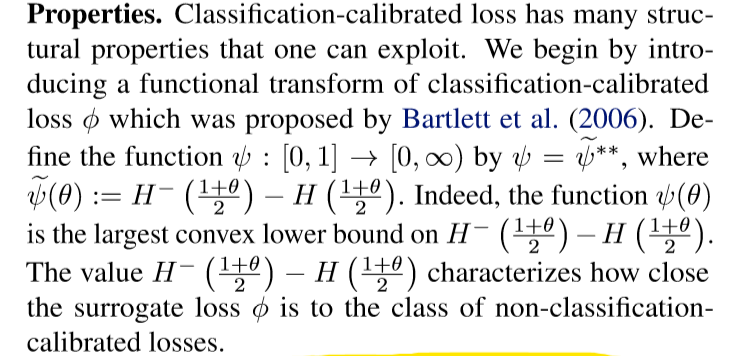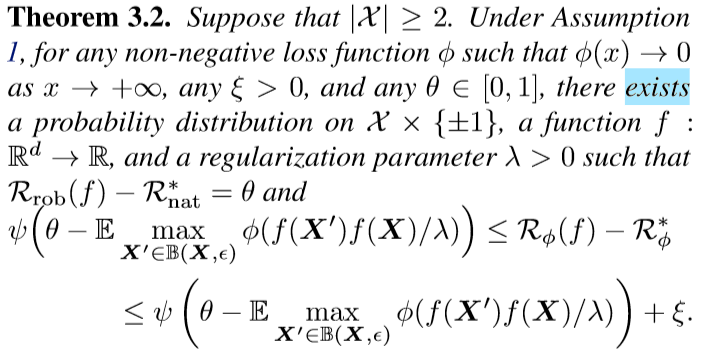文章目录
Zhang H, Yu Y, Jiao J, et al. Theoretically Principled Trade-off between Robustness and Accuracy[J]. arXiv: Learning, 2019.
@article{zhang2019theoretically,
title={Theoretically Principled Trade-off between Robustness and Accuracy},
author={Zhang, Hongyang and Yu, Yaodong and Jiao, Jiantao and Xing, Eric P and Ghaoui, Laurent El and Jordan, Michael I},
journal={arXiv: Learning},
year={2019}}
概
从二分类问题入手, 拆分 R r o b \mathcal{R}_{rob} Rrob为 R n a t , R b d y \mathcal{R}_{nat},\mathcal{R}_{bdy} Rnat,Rbdy, 通过 R r o b − R n a t ∗ \mathcal{R}_{rob}-\mathcal{R}_{nat}^* Rrob−Rnat∗的上界建立损失函数,并将这种思想推广到一般的多分类问题.
主要内容
符号说明
X , Y X, Y X,Y: 随机变量;
x ∈ X , y x\in \mathcal{X}, y x∈X,y: 样本, 对应的标签( 1 , − 1 1, -1 1,−1);
f f f: 分类器(如神经网络);
B ( x , ϵ ) \mathbb{B}(x, \epsilon) B(x,ϵ): { x ′ ∈ X : ∥ x ′ − x ∥ ≤ ϵ } \{x’\in \mathcal{X}:\|x’-x\| \le \epsilon\} {
x′∈X:∥x′−x∥≤ϵ};
B ( D B ( f ) , ϵ ) \mathbb{B}(DB(f),\epsilon) B(DB(f),ϵ): { x ∈ X : ∃ x ′ ∈ B ( x , ϵ ) , s . t . f ( x ) f ( x ′ ) ≤ 0 } \{x \in \mathcal{X}: \exist x’\in \mathbb{B}(x,\epsilon), \mathrm{s.t.} \: f(x)f(x’)\le0\} {
x∈X:∃x′∈B(x,ϵ),s.t.f(x)f(x′)≤0} ;
ψ ∗ ( u ) \psi^*(u) ψ∗(u): sup u { u T v − ψ ( u ) } \sup_u\{u^Tv-\psi(u)\} supu{
uTv−ψ(u)}, 共轭函数;
ϕ \phi ϕ: surrogate loss.
Error
R r o b ( f ) : = E ( X , Y ) ∼ D 1 { ∃ X ′ ∈ B ( X , ϵ ) , s . t . f ( X ′ ) Y ≤ 0 } , (e.1) \tag{e.1} \mathcal{R}_{rob}(f):= \mathbb{E}_{(X,Y)\sim \mathcal{D}}\mathbf{1}\{\exist X’ \in \mathbb{B}(X, \epsilon), \mathrm{s.t.} \: f(X’)Y \le 0\}, Rrob(f):=E(X,Y)∼D1{
∃X′∈B(X,ϵ),s.t.f(X′)Y≤0},(e.1)
其中 1 ( ⋅ ) \mathbf{1}(\cdot) 1(⋅)表示指示函数, 显然 R r o b ( f ) \mathcal{R}_{rob}(f) Rrob(f)是关于分类器 f f f存在adversarial samples 的样本的点的测度.
R n a t ( f ) : = E ( X , Y ) ∼ D 1 { f ( X ) Y ≤ 0 } , (e.2) \tag{e.2} \mathcal{R}_{nat}(f) :=\mathbb{E}_{(X,Y)\sim \mathcal{D}}\mathbf{1}\{f(X)Y \le 0\}, Rnat(f):=E(X,Y)∼D1{
f(X)Y≤0},(e.2)
显然 R n a t ( f ) \mathcal{R}_{nat}(f) Rnat(f)是 f f f正确分类真实样本的概率, 并且 R r o b ≥ R n a t \mathcal{R}_{rob} \ge \mathcal{R}_{nat} Rrob≥Rnat.
R b d y ( f ) : = E ( X , Y ) ∼ D 1 { X ∈ B ( D B ( f ) , ϵ ) , f ( X ) Y > 0 } , (e.3) \tag{e.3} \mathcal{R}_{bdy}(f) :=\mathbb{E}_{(X,Y)\sim \mathcal{D}}\mathbf{1}\{X \in \mathbb{B}(DB(f), \epsilon), \:f(X)Y > 0\}, Rbdy(f):=E(X,Y)∼D1{
X∈B(DB(f),ϵ),f(X)Y>0},(e.3)
显然
R r o b − R n a t = R b d y . (1) \tag{1} \mathcal{R}_{rob}-\mathcal{R}_{nat}=\mathcal{R}_{bdy}. Rrob−Rnat=Rbdy.(1)
因为想要最优化 0 − 1 0-1 0−1loss是很困难的, 我们往往用替代的loss ϕ \phi ϕ, 定义:
R ϕ ( f ) : = E ( X , Y ) ∼ D ϕ ( f ( X ) Y ) , R ϕ ∗ ( f ) : = min f R ϕ ( f ) . \mathcal{R}_{\phi}(f):= \mathbb{E}_{(X, Y) \sim \mathcal{D}} \phi(f(X)Y), \\ \mathcal{R}^*_{\phi}(f):= \min_f \mathcal{R}_{\phi}(f). Rϕ(f):=E(X,Y)∼Dϕ(f(X)Y),Rϕ∗(f):=fminRϕ(f).
Classification-calibrated surrogate loss
这部分很重要, 但是篇幅很少, 我看懂, 等回看了引用的论文再讨论.
引理2.1
定理3.1
在假设1的条件下 ϕ ( 0 ) ≥ 1 \phi(0)\ge1 ϕ(0)≥1, 任意的可测函数 f : X → R f:\mathcal{X} \rightarrow \mathbb{R} f:X→R, 任意的于 X × { ± 1 } \mathcal{X}\times \{\pm 1\} X×{
±1}上的概率分布, 任意的 λ > 0 \lambda > 0 λ>0, 有
R r o b ( f ) − R n a t ∗ ≤ ψ − 1 ( R ϕ ( f ) − R ϕ ∗ ) + P r [ X ∈ B ( D B ( f ) , ϵ ) , f ( X ) Y > 0 ] ≤ ψ − 1 ( R ϕ ( f ) − R ϕ ∗ ) + E max X ′ ∈ B ( X , ϵ ) ϕ ( f ( X ′ ) f ( X ) / λ ) . \begin{array}{ll} & \mathcal{R}_{rob}(f) – \mathcal{R}_{nat}^* \\ \le & \psi^{-1}(\mathcal{R}_{\phi}(f)-\mathcal{R}_{\phi}^*) + \mathbf{Pr}[X \in \mathbb{B}(DB(f), \epsilon), f(X)Y >0] \\ \le & \psi^{-1}(\mathcal{R}_{\phi}(f)-\mathcal{R}_{\phi}^*) + \mathbb{E} \quad \max _{X’ \in \mathbb{B}(X, \epsilon)} \phi(f(X’)f(X)/\lambda). \\ \end{array} ≤≤Rrob(f)−Rnat∗ψ−1(Rϕ(f)−Rϕ∗)+Pr[X∈B(DB(f),ϵ),f(X)Y>0]ψ−1(Rϕ(f)−Rϕ∗)+EmaxX′∈B(X,ϵ)ϕ(f(X′)f(X)/λ).
最后一个不等式, 我知道是因为 ϕ ( f ( X ′ ) f ( X ) / λ ) ≥ 1. \phi(f(X’)f(X)/\lambda) \ge1. ϕ(f(X′)f(X)/λ)≥1.
定理3.2
结合定理 3.1 , 3.2 3.1, 3.2 3.1,3.2可知, 这个界是紧的.
由此导出的TRADES算法
二分类问题, 最优化上界, 即:
扩展到多分类问题, 只需:
算法如下:
实验概述
5.1: 衡量该算法下, 理论上界的大小差距;
5.2: MNIST, CIFAR10 上衡量 λ \lambda λ的作用, λ \lambda λ越大 R n a t \mathcal{R}_{nat} Rnat越小, R r o b \mathcal{R}_{rob} Rrob越大, CIFAR10上反映比较明显;
5.3: 在不同adversarial attacks 下不同算法的比较;
5.4: NIPS 2018 Adversarial Vision Challenge.
代码
import torch
import torch.nn as nn
def quireone(func): #a decorator, for easy to define optimizer
def wrapper1(*args, **kwargs):
def wrapper2(arg):
result = func(arg, *args, **kwargs)
return result
wrapper2.__doc__ = func.__doc__
wrapper2.__name__ = func.__name__
return wrapper2
return wrapper1
class AdvTrain:
def __init__(self, eta, k, lam,
net, lr = 0.01, **kwargs):
""" :param eta: step size for adversarial attacks :param lr: learning rate :param k: number of iterations K in inner optimization :param lam: lambda :param net: network :param kwargs: other configs for optim """
kwargs.update({
'lr':lr})
self.net = net
self.criterion = nn.CrossEntropyLoss()
self.opti = self.optim(self.net.parameters(), **kwargs)
self.eta = eta
self.k = k
self.lam = lam
@quireone
def optim(self, parameters, **kwargs):
""" quireone is decorator defined below :param parameters: net.parameteres() :param kwargs: other configs :return: """
return torch.optim.SGD(parameters, **kwargs)
def normal_perturb(self, x, sigma=1.):
return x + sigma * torch.randn_like(x)
@staticmethod
def calc_jacobian(loss, inp):
jacobian = torch.autograd.grad(loss, inp, retain_graph=True)[0]
return jacobian
@staticmethod
def sgn(matrix):
return torch.sign(matrix)
def pgd(self, inp, y, perturb):
boundary_low = inp - perturb
boundary_up = inp + perturb
inp.requires_grad_(True)
out = self.net(inp)
loss = self.criterion(out, y)
delta = self.sgn(self.calc_jacobian(loss, inp)) * self.eta
inp_new = inp.data
for i in range(self.k):
inp_new = torch.clamp(
inp_new + delta,
boundary_low,
boundary_up
)
return inp_new
def ipgd(self, inps, ys, perturb):
N = len(inps)
adversarial_samples = []
for i in range(N):
inp_new = self.pgd(
inps[[i]], ys[[i]],
perturb
)
adversarial_samples.append(inp_new)
return torch.cat(adversarial_samples)
def train(self, trainloader, epoches=50, perturb=1, normal=1):
for epoch in range(epoches):
running_loss = 0.
for i, data in enumerate(trainloader, 1):
inps, labels = data
adv_inps = self.ipgd(self.normal_perturb(inps, normal),
labels, perturb)
out1 = self.net(inps)
out2 = self.net(adv_inps)
loss1 = self.criterion(out1, labels)
loss2 = self.criterion(out2, labels)
loss = loss1 + loss2
self.opti.zero_grad()
loss.backward()
self.opti.step()
running_loss += loss.item()
if i % 10 is 0:
strings = "epoch {0:<3} part {1:<5} loss: {2:<.7f}\n".format(
epoch, i, running_loss
)
print(strings)
running_loss = 0.
今天的文章Theoretically Principled Trade-off between Robustness and Accuracy分享到此就结束了,感谢您的阅读。
版权声明:本文内容由互联网用户自发贡献,该文观点仅代表作者本人。本站仅提供信息存储空间服务,不拥有所有权,不承担相关法律责任。如发现本站有涉嫌侵权/违法违规的内容, 请发送邮件至 举报,一经查实,本站将立刻删除。
如需转载请保留出处:https://bianchenghao.cn/65876.html







